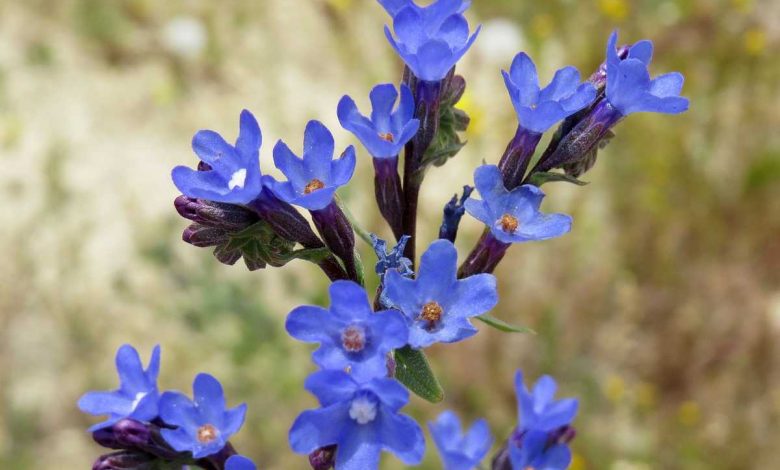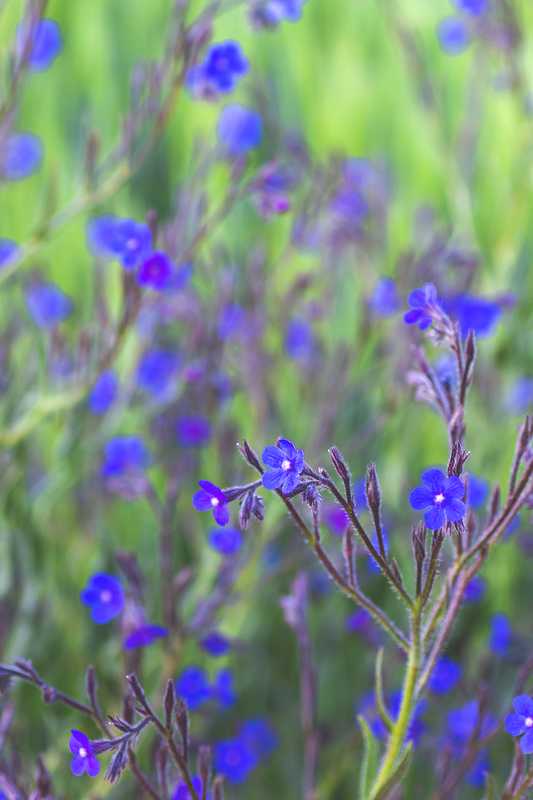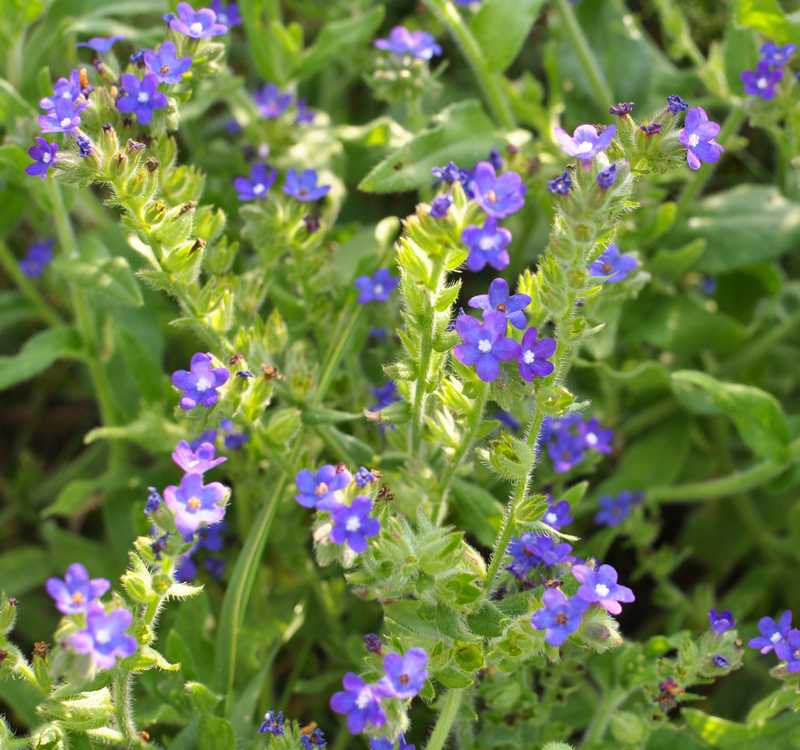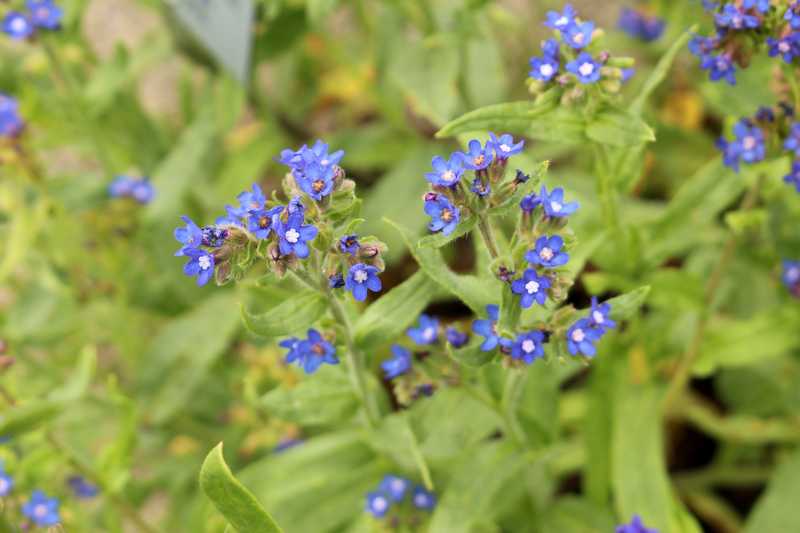
Rock of Myosotis and borage, bugloss is a biennial plant or an ephemeral perennial . Grown in a natural-type garden, its blue flowers go well with other early summer blooms.
What there is to know :
Name: Buglosse, beech-tongue Botanical
Botanical name: Anchusa azurea, Anchusa italica, Anchusa capensis
Origin: Peruvian Mediterranean
Family: Borraginaceae
Height and spreading: Depending on the variety, the buglosses generally form a clump of 1m to 1m50 in height for about 50cm of spreading. Their growth is rapid.
Foliage: Bugloss takes on an erect habit with lanceolate green leaves, rough to the touch and hairy. This elongated shape of the leaves and especially their rough feel has earned the bugloss its nickname of langue-de-boeuf .
Flowering: Depending on the variety, the flowers open from May to July at the ends and sides of flower stems with leaves. All buglosses have blue flowers but of different shades.
Exposure: In the sun
Soil: Undemanding, buglosses grow in all types of soil, even clay soils which they do not fear. They also tolerate slightly calcareous soils. In any case, good drainage makes them more resistant to the cold in winter and prolongs their lifespan. These plants are particularly sensitive to excess humidity .
Hardy: Down to -15°C if grown in good conditions.

Cultivation of bugloss: Planting and sowing
Planting is done in spring and can be brought forward to autumn in regions with a mild climate, because some buglosses are biennial, others are perennial.
A warm sunny and ideally rocky location offers the best growing conditions for this beautiful flowering plant.
In August September, sow bugloss seeds in a terrine or directly in a bucket. Keep out of the cold all winter to transplant them into the ground in early spring.
Plant the perennial buglosses from pots ideally in early fall , so that they have time to take root well before winter.
How to maintain buglosses?
Easy to grow, bugloss is also easy to care for and almost insensitive to disease.
Remove faded flowers as you go, then cut the entire flower stem flush if you want to prevent the plant from reseing itself. This will allow you to enjoy longer flowering.
In winter, buglosses are resistant to cold if the soil is very well drained. You can therefore provide minimal protection against the risk of freezing of superficial roots by spreading a mulch of dead leaves.
Watering : Buglosses are also very resistant to drought. Except during scorching summers, it is often unnecessary to water them .
Fertilizer : A deep soil enriched with compost makes it possible to obtain beautiful, very flowering plants. Add compost when planting and for maintenance in the fall.
Staking : Buglosses tend to lie down under their weight or with the wind, so they need discreet staking or plant support around them. Do not hesitate. To pinch the stems in the spring to cause them to branch.

How to take cuttings and multiply bugloss?
Buglosses have a short lifespan . They rarely live more than 3 years.
Root cuttings, done in February, March, or August, are the best way to propagate them . Prepare root sections 3 to 5 cm in length using a knife. Then plant them in a pot or terrine that you will keep under cold shelter until their final planting in autumn.
If you keep its deflowered stems, the bugloss will also reseed itself spontaneously . Do not hesitate to take young plants in spring or autumn to replant immediately elsewhere.
How to use buglosses in the garden?
Like lungwort , borage , bugloss or forget-me-nots, which are similar to buglosses, these plants thrive in a natural garden . They are particularly useful to complete the perennials of a massif by bringing a wild touch.
Mix them with Oriental poppy, roses , garden irises , kniphofias , lupins or delphiniums . The blue color of bugloss flowers blend well with the yellow or white and gray leaves of sagebrush.
On the other hand, buglosses do not like pots or planters .

The best varieties
Buglosses form a large family comprising about 35 species of plants, most of which are biennials or perennials. Here are the most cultivated in the gardens.
Italian Bugloss, Anchusa azurea or Anchusa italica
Biennial or perennial forming tufts 1m to 1m50 high, with flowers resembling those of forget-me-nots, but larger and of a pretty bright blue. Flowering: May to July.
- Anchusa azurea Loddon Royalist : With large gentian blue flowers. H: 1m
- Anchusa azurea Dropmore : with very bright blue flowers. H: 1m
Cape Bugloss, Anchusa capensis
Biennial forming a lower tuft of long, narrow, hairy, rough leaves. The blue flowers bloom at the ends of stems 50 cm tall. Flowering: June to September.
Bugloss, Anchusa officinalis , and Field Bugloss, Anchusa arvensis
2 annuals with blue flowers that grow spontaneously in vineyards, fallow land and roadsides.
